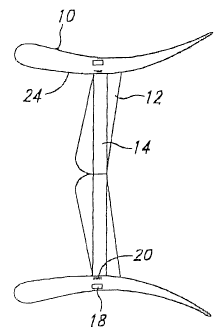Some of the information on this Web page has been provided by external sources. The Government of Canada is not responsible for the accuracy, reliability or currency of the information supplied by external sources. Users wishing to rely upon this information should consult directly with the source of the information. Content provided by external sources is not subject to official languages, privacy and accessibility requirements.
Any discrepancies in the text and image of the Claims and Abstract are due to differing posting times. Text of the Claims and Abstract are posted:
| (12) Patent: | (11) CA 2388513 |
|---|---|
| (54) English Title: | POWER STATION USING OCEAN CURRENTS |
| (54) French Title: | CENTRALE ELECTRIQUE UTILISANT LES COURANTS MARINS |
| Status: | Expired |
| (51) International Patent Classification (IPC): |
|
|---|---|
| (72) Inventors : |
|
| (73) Owners : |
|
| (71) Applicants : |
|
| (74) Agent: | OYEN WIGGS GREEN & MUTALA LLP |
| (74) Associate agent: | |
| (45) Issued: | 2005-01-04 |
| (86) PCT Filing Date: | 2000-08-08 |
| (87) Open to Public Inspection: | 2001-04-12 |
| Examination requested: | 2002-10-04 |
| Availability of licence: | N/A |
| (25) Language of filing: | English |
| Patent Cooperation Treaty (PCT): | Yes |
|---|---|
| (86) PCT Filing Number: | PCT/EP2000/007665 |
| (87) International Publication Number: | WO2001/025627 |
| (85) National Entry: | 2002-04-03 |
| (30) Application Priority Data: | ||||||
|---|---|---|---|---|---|---|
|
The invention concerns a marine current power installation. This
involves not just a known tidal power installation which makes use of the
energy of tidal ebb and flow, but a power installation which takes energy
from marine currents which constantly occur over all oceans.
The invention proposes designing a marine current power
installation which takes kinetic energy of flow from the marine current and
converts the taken energy into electrical energy. In that case the marine
current water power installation according to the invention is used below
the water level, for example more than 50 m below the water level, and
can make a relatively large amount of power available even when the flow
speed of the marine current is relatively low, for example in the region of
1.5 m/sec or less. That is achieved in that the water power installation
has a water wheel or a rotor (turbine or propeller) which is of a diameter
of for example 10 m or more, preferably between 30 m and 120 m.
L'invention concerne une centrale électrique utilisant les courants marins. Cette centrale est transportable. Son boîtier et son rotor creux peuvent être remplis d'eau à volonté ou vidés. Cela permet de régler ou de modifier la profondeur d'immersion de la centrale.
Note: Claims are shown in the official language in which they were submitted.
Note: Descriptions are shown in the official language in which they were submitted.

For a clearer understanding of the status of the application/patent presented on this page, the site Disclaimer , as well as the definitions for Patent , Administrative Status , Maintenance Fee and Payment History should be consulted.
| Title | Date |
|---|---|
| Forecasted Issue Date | 2005-01-04 |
| (86) PCT Filing Date | 2000-08-08 |
| (87) PCT Publication Date | 2001-04-12 |
| (85) National Entry | 2002-04-03 |
| Examination Requested | 2002-10-04 |
| (45) Issued | 2005-01-04 |
| Expired | 2020-08-10 |
There is no abandonment history.
| Fee Type | Anniversary Year | Due Date | Amount Paid | Paid Date |
|---|---|---|---|---|
| Application Fee | $300.00 | 2002-04-03 | ||
| Maintenance Fee - Application - New Act | 2 | 2002-08-08 | $100.00 | 2002-04-03 |
| Request for Examination | $400.00 | 2002-10-04 | ||
| Advance an application for a patent out of its routine order | $100.00 | 2002-10-11 | ||
| Maintenance Fee - Application - New Act | 3 | 2003-08-08 | $100.00 | 2003-06-20 |
| Maintenance Fee - Application - New Act | 4 | 2004-08-09 | $100.00 | 2004-06-16 |
| Final Fee | $300.00 | 2004-10-20 | ||
| Maintenance Fee - Patent - New Act | 5 | 2005-08-08 | $200.00 | 2005-07-21 |
| Maintenance Fee - Patent - New Act | 6 | 2006-08-08 | $200.00 | 2006-07-20 |
| Maintenance Fee - Patent - New Act | 7 | 2007-08-08 | $200.00 | 2007-07-19 |
| Maintenance Fee - Patent - New Act | 8 | 2008-08-08 | $200.00 | 2008-07-28 |
| Maintenance Fee - Patent - New Act | 9 | 2009-08-10 | $200.00 | 2009-07-28 |
| Maintenance Fee - Patent - New Act | 10 | 2010-08-09 | $250.00 | 2010-07-27 |
| Maintenance Fee - Patent - New Act | 11 | 2011-08-08 | $250.00 | 2011-07-25 |
| Maintenance Fee - Patent - New Act | 12 | 2012-08-08 | $250.00 | 2012-07-26 |
| Maintenance Fee - Patent - New Act | 13 | 2013-08-08 | $250.00 | 2013-07-25 |
| Maintenance Fee - Patent - New Act | 14 | 2014-08-08 | $250.00 | 2014-07-28 |
| Maintenance Fee - Patent - New Act | 15 | 2015-08-10 | $450.00 | 2015-07-27 |
| Maintenance Fee - Patent - New Act | 16 | 2016-08-08 | $450.00 | 2016-07-25 |
| Maintenance Fee - Patent - New Act | 17 | 2017-08-08 | $450.00 | 2017-07-25 |
| Maintenance Fee - Patent - New Act | 18 | 2018-08-08 | $450.00 | 2018-07-25 |
Note: Records showing the ownership history in alphabetical order.
| Current Owners on Record |
|---|
| WOBBEN, ALOYS |
| Past Owners on Record |
|---|
| None |